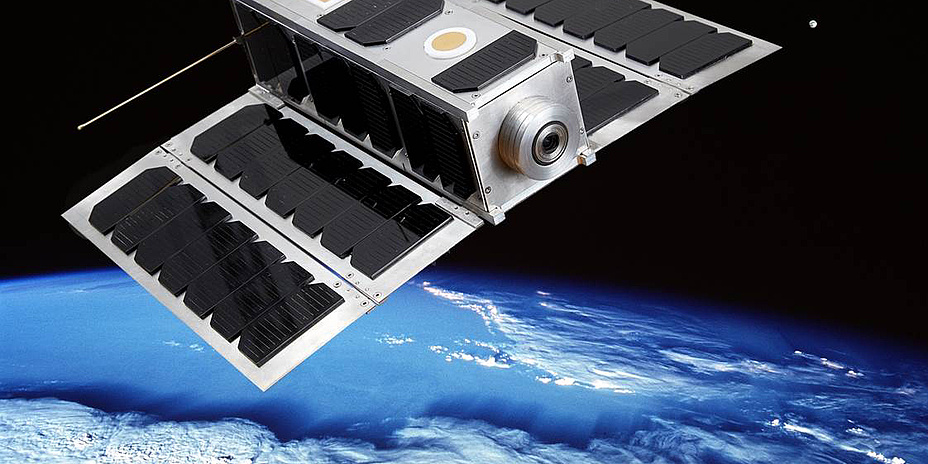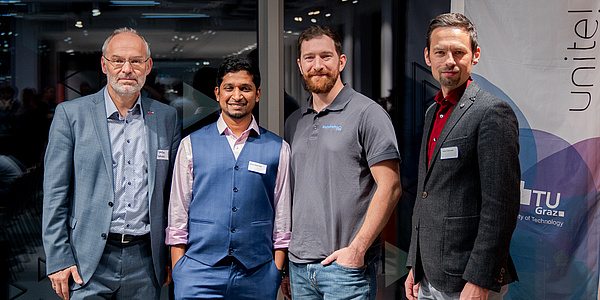Between heavenly bodies: TU Graz in space

On 4 October 1991, in a classical Austrian way, the Vienna Philharmonic Orchestra played the Blue Danube by Johann Strauss as Franz Viehböck, the one and only Austrian cosmonaut to go into space, glided into the Soviet space station “Mir”. Willi Boskovsky, the longtime conductor of the Vienna Philharmonic Orchestra, would have definitely been proud of his nephew. But not of Franz Viehböck, but rather Willibald Riedler. Proud of the man who had overall scientific responsibility for the Austrian-Soviet mission, and had earned the sobriquet “the pope of space”. A name he doesn’t like. He prefers to be called the “space professor”.
AUSTROMIR: the first Austrian in space
Fascinated by the moon as a small child, communications engineer Willibald Riedler is today inseparably associated with Austrian space research. After studies in Vienna and research years in Kiruna, Sweden, he was appointed professor at TU Graz in 1968. Only one year later, a research rocket took off with the first Austrian measuring device on board on his initiative. These were the first traces of TU Graz in the infinite expanse of space. Subsequently, Riedler always managed to dispatch Austrian measuring devices into interplanetary space on board European, American, Russian and Chinese satellites. This remained unnoticed internationally. He was appointed scientific head of the AUSTROMIR mission, a Soviet-Austrian project in the context of which the Austrian cosmonaut Franz Viehböck spent one week in the Russian space station in 1991 to conduct research on the effects of weightlessness on the human body.
GOCE: Ferrari among satellites
Willibald Riedler was Rector of TU Graz in the 1970s, Director of the Space Research institute of the Austrian Academy of Sciences, head of the Institute of Applied Systems Engineering at Joanneum Research – and is today mentor and inspiration for a young generation of researchers. Another former Rector of TU Graz is well known in international space research – Hans Sünkel. And not only because an asteroid was named after him in 1992. The successful ESA mission GOCE also bears the hallmark of the geodesist, who served as Rector of TU Graz from 2003 to 2011. Because of its unusually – for satellites – elegant, aerodynamic form, the research satellite GOCE was also called the “Ferrari of space”. For more than four years, the exploratory satellite gathered highly precise data about the Earth’s gravitational field before most of it burned up while reentering the Earth’s atmosphere in 2013. Hans Sünkel got this showcase mission off the ground as head of the Institute of Theoretical Geodesy and also headed – even as Rector of TU Graz – the European GOCE consortium.
TUGSAT-1: the first red-white-red satellite
When one door closes, another door opens. The year which saw the ending of the GOCE mission and its remains burning up over the South Atlantic was also the year of an Austrian premiere. TUGSAT-1 was launched in February 2013 and was the first red-white-red satellite to go into orbit. The roughly seven-kilogram nanosatellite was built and tested by a group headed by Otto Koudelka at the Institute of Communication Networks and Satellite communications of TU Graz with the aim – as part of a group of nanosatellites – of gathering information about the brightness variability of bright massive stars. The satellite was meant to carry out its work at a height of about 800 kilometers for two years – a minimum lifetime which TUGSAT-1 has by far exceeded. Even today, ten years later, it still sends valuable data to the ground station at TU Graz’s Inffeldgasse Campus each time it flies over Europe. What makes TUGSAT-1 so special is the intensive work of a new generation of scientists. Students have been directly involved in all phases of the project and play an indispensable role in the management of the complex space project. The nanosatellite still keeps researchers at TU Graz on their toes. . After intensive construction and test phases – in special vacuum and thermal chambers, on the vibration table and in the clean room – and logistics surrounding the launch of the satellite, today emphasis is on the operation of both satellite and ground station and the constant gathering and evaluation of data. A small cube by which Austria catapulted itself into the league of space nations.
OPS-SAT: a laboratory in space
The great success of TUGSAT-1 is definitely a reason why in 2015 ESA placed another top-class nanosatellite project in the hands of Otto Koudelka and his team at TU Graz. Since its launch in 2019 OPS-SAT has been helping to develop and test new space technologies as a kind of mini-laboratory. Currently communication standards from the 1980s and 1990s are still being followed in the satellite business. The processors in space technology are several generations behind those used on Earth. The older technologies have their justification. “For reasons of safety, ESA relies on well-proven technology – just like other space organisations – and wants to be on the safe side. OPS-SAT helps to carry out in-orbit tests on space software, and under the auspices of TU Graz validates new operational concepts of ESA in flight. The aim of the mission is to test new high-performance processors, radio receivers and space software under real space conditions at low risk. A camera facing the Earth is also on board. As with TUGSAT-1 a young generation of researchers are extensively involved at all project levels.
JUICE: a mission to the icy moons of Jupiter
In autumn 2015 the next space success for TU Graz was bagged. As partner in the ESA-mission JUICE, TU Graz is involved in an exploratory tour to the outer limits of the solar system – to Europa, Ganymede and Callisto, the three ice moons of Jupiter. Under the icy surface of the Jupiter moons, giant oceans of water are suspected. Eleven scientific measuring instruments are being developed worldwide for this mission. Together with the Space Research Institute (IWF) of the Austrian Academy of Sciences, a team led by Roland Lammegger of the Institute of Experimental Physics of TU Graz is responsible for the novel quantum interference magnometer on board JUICE. The group from TU Graz is developing the optical sensor system of the magnometer, and the Space Research Institute will contribute to the space-compatible electronics. By means of the magnetic field measurement, researchers will be able to proverbially see into the moon. Where electrical fields flow, magnetic fields stand out – provided there are electrically conductive layers, such as water. The conductivity of the layers can lead to conclusions about the internal structure of the heavenly body. Some eight years after the launch from the spaceport in French Guiana, which is currently scheduled for summer 2023, the JUICE probe will reach the gas giant Jupiter in 2030. From the point of view of ESA, the JUICE mission has the same status as the successful Rosetta mission.
PRETTY: a nanosatellite for climate observation
In 2023, the next Austrian satellite fully built and tested and ready for launch into orbit: PRETTY will be the sixth Austrian satellite in space, and the third made and tested by TU Graz. The customer of the climate observation satellite is the European Space Agency ESA. Beyond Gravity Austria (formerly RUAG Space) is responsible for the overall project management. PRETTY is an acronym for Passive REflectomeTry and dosimeTrY and will host two scientific experiments as payloads. The centrepiece is a passive reflectometer system for precise measurement of the Earth’s surfaces, developed by Beyond Gravity (concept and software system) and the Institute of Communication Networks and Satellite Communications at TU Graz (hardware). The small satellite will use the reflectometer system to measure the extent of ice and sea heights as well as ocean currents. To measure the radiation environment in space, Seibersdorf Laboratories GmbH has developed, built and tested a novel dosimeter platform. The dosimeter payload is active during the entire PRETTY mission and collects scientific data. TU Graz was responsible for the satellite platform, carried out the manufacturing, assembly, integration and testing activities and will operate the satellite from the ground station at Campus Inffeldgasse.
Every space mission in which the people of TU Graz are involved is a true star hour for TU Graz and proof that reaching for the stars is also possible from Styria.
Kontakt
Susanne FILZWIESER
TU Graz | Communications and Marketing
Tel.: +43 316 873 4566
susanne.filzwieser@tugraz.at




